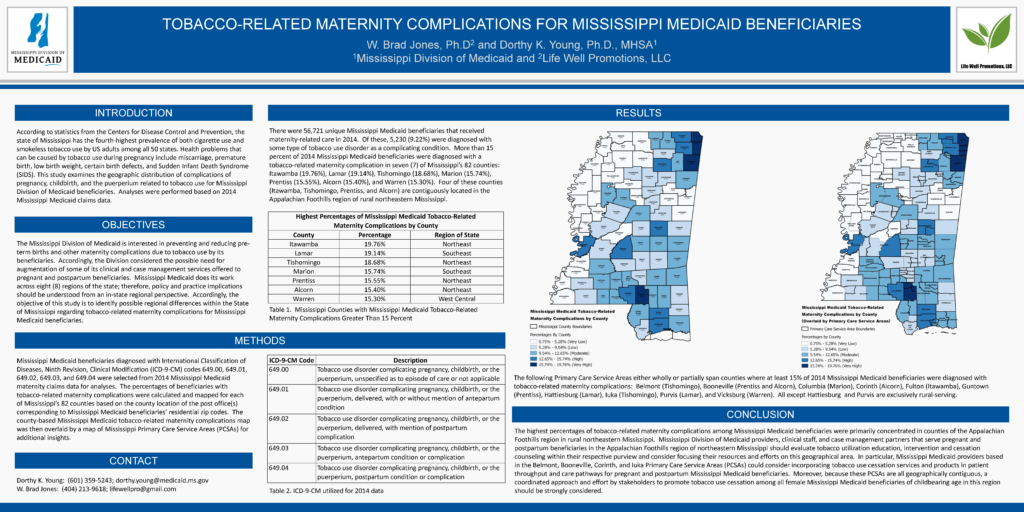This article is part six of a six-part blog series with Dr. Brad Jones.
Introduction
In our final blog post of this series, we’re taking a look at how geo-cultural assessments can provide insights and drive decision making for state Medicaid providers. In 2018, Dr. Brad Jones presented alongside then-Mississippi Medicaid Deputy Administrator of Health Services, Dr. Dorthy Young, on Tobacco-Related Maternity Complications for Mississippi Medicaid Beneficiaries. Dr. Jones shares his experience and takeaways related to this project below.
How did you get involved in the research project and what was your role throughout?
I entered into a contractual agreement with the Mississippi Division of Medicaid to perform strategic planning consultation based on research and data analyses applied to all counties within its service region, with a particular focus on rural counties. Mississippi Medicaid was interested in preventing and reducing preterm births due to maternity complications arising from selected risk factors. Â Consequently, they provided me with maternity claims data that I analyzed to understand the prevalence of maternity complications among Mississippi Medicaid beneficiaries due to the following risk factors: diabetes, hypertension, obesity, and tobacco use. In particular, I was interested in understanding both the relative levels and geographic distribution of maternity complications due to each of these risk factors. I thought it may be beneficial for Mississippi Medicaid to know whether or not there were geographically-based differences in these outcomes so they could develop and tailor regionally-relevant case management and program strategies.
After presenting this idea to Mississippi Medicaid administration and staff, they agreed that the prospective results would be valuable to the Division and supported this approach. Results from the analyses indicated that of the four risk factors studied, only one had a clearly distinguishable difference in prevalence based on geographic location: tobacco use. Prevalence of maternity complications due to tobacco use among Mississippi Medicaid beneficiaries was clearly higher in the northeastern counties of the state than in the rest of the state. The Appalachian Regional Commission considers these counties as the southwestern-most counties of Appalachia where, according to the West Virginia Department of Health and Human Services and other research sources over the years, smoking prevalence is higher than the rest of the nation (Meyer et al., 2008; Schoenberg et al., 2015). Accordingly, my finding that maternity complications due to tobacco use was higher among Mississippi Medicaid beneficiaries living in the Appalachian portion of Mississippi than in the rest of the state was consistent with findings from other previous research studies.
How did this research add value or change outcomes for the Mississippi Division of Medicaid?
This research finding added value for the Mississippi Division of Medicaid by strengthening and enhancing their ability to communicate with state legislators and other key stakeholders about a specific adverse health outcome that was disproportionately affecting Mississippi Medicaid beneficiaries living in a particular region of the state. It also provided the Division with additional evidence-based information to incorporate into their strategic planning and programming efforts, if and when deemed necessary.
How can doing research like this add value to potential Truitt Health clients?
Identifying and understanding differences in health outcomes from a socio-cultural and geographic perspective can be extremely beneficial to organizations tasked with serving multicultural and geographically-diverse populations. For starters, it can enable organizations to identify where and among whom certain health outcomes might be disproportionately affecting, which can lead to more cost-effective and strategic deployment of resources. Moreover, findings from this kind of research can provide organizations with the evidence they need to tailor their efforts and initiatives to local cultural contexts, enabling more effective, culturally-competent, and culturally-relevant delivery of health services and programs.

References
Meyer, M.G., Toborg, M.A., Denham, S.A., and Mande, M.J. (2008). Cultural Perspectives Concerning
Adolescent Use of Tobacco and Alcohol in the Appalachian Mountain Region. Â Journal of Rural Health, 24, 1, 67-74.
Schoenberg, N.E., Huang, B., Seshadri, S., and Tucker, T.C. (2015). Trends in Cigarette Smoking and
Obesity in Appalachian Kentucky. Southern Medical Journal, 108, 3, 170-177.
